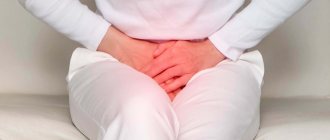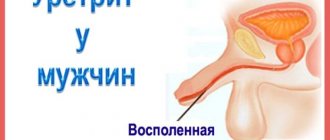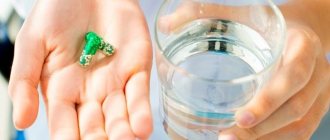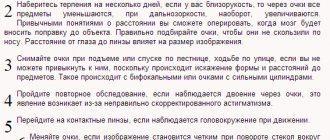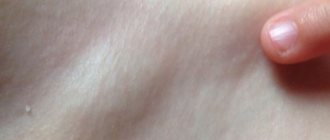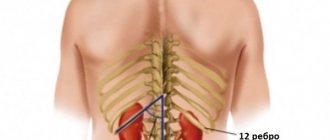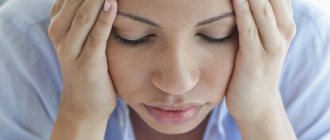A burning sensation in the lower back can be evidence of a variety of pathologies: diseases of the spine, pinched nerves, diseases of the internal organs. You should not ignore this symptom, as it not only brings great discomfort, but can also lead to serious health problems in the future.
From this article you will learn what causes pain and burning in the lower back, what list of symptoms indicates the presence of a serious disease and how to treat it at home.
- Drug therapy
Causes
The sources of the problem can be divided into two groups. In most cases, the cause of burning and pain in the lower back is pathology of the spine. In this case, the disorder can develop in any of its departments, but the pain can be felt in the lower back. The second group of reasons is diseases of internal organs. In the presence of inflammation in the abdominal cavity or pelvis, pinched nerves and impaired circulation occur, which causes unpleasant symptoms of burning in the lumbar region.
Possible diseases
Let's consider a list of spinal pathologies, which in most cases lead to a burning sensation in the lumbar region.
Osteochondrosis
This pathology is characterized by thinning of the intervertebral discs, resulting in contact of the vertebrae. Bone growths form on the vertebrae - osteophytes, which compress blood vessels and nerves. Osteochondrosis can be caused by a sedentary lifestyle, poor posture, or injury.
Intervertebral hernia
Intervertebral discs serve as a kind of shock absorption, which ensures mobility of the vertebrae. With curvature of the ridge, prolonged sitting, improper and excessive physical activity, the vertebrae compress the intervertebral disc too much. Because of this, its contents - the gelatinous pulp - protrude beyond the bone shell, this is called a hernia. The protrusion can compress blood vessels and nerves, which causes a burning sensation and pain.
Schmorl's knot
It is a hernia formed due to prolapse of the nucleus of the intervertebral disc, but directed inside the vertebral body. It is often a congenital pathology or appears during the period of active growth of the child, when the skeletal system lacks strength.
Spinal stenosis
The vertebrae, due to their processes, form a cavity through which the spinal cord passes. When the vertebrae are deformed or a hernia prolapses towards the spinal canal, compression of the spinal cord occurs, which results in severe pain.
Scoliosis, lordosis
These are types of spinal curvature in which the load is incorrectly distributed along the entire length of the spinal column. As a result, some muscles are subject to severe spasms, while others are relaxed. As a result, the person feels a strong burning sensation.
Other reasons
Also, a burning sensation and pain in the lower back may appear for reasons not related to diseases of the spine.
The most popular category includes diseases of the genitourinary system. This can be inflammation of the prostate in men, diseases of the uterus and ovaries in women. Also, in women, such negative symptoms can appear during an ectopic pregnancy or during pregnancy after the second trimester, when the stomach becomes very large and shifts the center of gravity.
Lower back pain can occur due to kidney pathology, as well as gastrointestinal diseases. The presence of these diseases will be indicated by additional symptoms: urinary disorders in kidney diseases, nausea after eating, vomiting, abdominal pain in gastrointestinal diseases. Consulting with a doctor will help determine the exact cause of negative symptoms.
Burning sensation in the back - causes
Possible causes of back burning include:
Neuralgia
Neuralgia is the most common cause of warm, burning, tingling back pain. While muscle pain causes tension, soreness, and a dull or sharp ache, nerve pain causes unusual sensations such as:
- burning;
- tingling;
- insensitivity;
- shooting pains;
- sudden jolts that feel like an electric shock.
Feeling hot
is a type of neurological pain.
A damaged or compressed nerve cannot send the normal signal, so the body may interpret the sensation as warmth. People with diabetes may develop a type of pain called diabetic neuropathy
.
High levels of glucose and triglycerides in the blood can damage nerves, causing unusual or painful sensations, including numbness, tingling, and burning. The most common type of neuropathy is peripheral neuropathy
, which affects the feet and hands. However, some people develop focal neuropathy, which damages individual nerves, often in the trunk, arm, leg, or head, such as femoral neuropathy.
Radiculopathy
is pain resulting from compression, damage or inflammation of the spinal nerve. Radiculopathy can cause pain in any part of the back. Sciatica is a common type of radiculopathy that compresses the sciatic nerve, which runs down the back of the leg. It can cause lower back pain as well as a burning sensation that spreads from the buttock down the leg.
Sunburn
During periods of hot weather, the sun can cause skin burns. A sunburn often feels hot to the touch and can also cause a burning, tingling pain. The skin may become red and flaky. Some medications, including retinoids
and
salicylic acid
,
sulfonamides
,
nonsteroidal anti-inflammatory drugs
, and some
diuretics
, increase the risk of sunburn. Most sunburns go away on their own, but they can be very painful and increase your risk of developing skin cancer. A severe sunburn can cause blistering, dehydration, fever and other dangerous symptoms. A person with a severe sunburn needs treatment.
Skin infection
Skin infections can cause a burning sensation. A skin infection causes swelling, pain near the affected area, and redness. Serious skin infections may cause fever or flu-like symptoms.
Skin cellulitis is an infection of the deep layers of the skin that often causes a feeling of warmth. Cellulitis can be dangerous if left untreated as it can cause a systemic infection called sepsis
. A person with symptoms of skin cellulitis needs treatment, including antibiotics. In some cases, hospitalization may be required.
Heartburn
Heartburn occurs when stomach contents, especially stomach acid, back up into the esophagus. This can happen after a person has eaten sour food. Heartburn is also a common symptom of gastroesophageal reflux disease
(GERD). Heartburn may cause pain in the center of the chest or throat, but severe cases of heartburn may cause back pain. A person may experience a burning sensation in the middle of the upper back.
Stones in the kidneys
Kidney stones form when the level of minerals such as calcium is too high in the urine. Some people develop kidney stones during a urinary tract infection. Kidney stones can cause sharp pain in the lower back, usually on one side. Although most people describe the pain as severe, some say they feel a burning sensation. The pain may radiate to the groin. When a stone passes, a person may feel a burning sensation in the groin or lower back, as well as severe cramps.
Symptoms
Symptoms in patients can be very different, it all depends on the reasons that caused the burning sensation and pain. The feeling of discomfort can appear locally at one point or cover the entire lumbar region. The nature of the pain can be different: sharp, aching, stabbing, pulling. In terms of intensity, the pain can be acute - a pronounced symptom that may not go away for up to several weeks, or chronic - less pronounced than acute, but having a longer duration.
In the presence of pathologies of the spine, other symptoms are added to the burning and pain:
- dizziness;
- spasms after a long stay in one position;
- itching, redness and swelling of the skin on the lower back;
- impaired mobility of the limbs, a feeling of stiffness in the body;
- numbness of the skin on the lower back.
If the symptoms were caused by kidney disease, itching and pain when urinating, purulent and bloody inclusions in the urine may appear. Gynecological problems in women, in addition to back pain, cause cycle disorders, vaginal discharge, and increased body temperature. Prostate diseases in men stimulate not only a burning sensation in the lower back, but also pain during tension in the pelvic area, sexual dysfunction, and general malaise.
Symptoms
If a burning sensation in the spine is caused by diseases of the musculoskeletal system, then the following clinical picture may be present:
- stiffness in movements, which manifests itself most intensely in the morning or after a long stay at complete rest;
- muscle weakness;
- stiffness in movements, which may become more intense as the pathological process worsens;
- joint pain;
- feeling of coldness in the fingers of the lower and upper extremities;
- tremor of the limbs;
- local increase in temperature, swelling and redness of the skin;
- muscle contracture;
- sharp pains that can pierce the back, now on the left, now on the right, radiating to the leg;
- problems with potency in men.
In case of ailments of the cardiovascular system, a burning sensation in the lumbar region will be accompanied by the following symptoms:
- pain in the chest area, which will be accompanied by a burning sensation in the chest area;
- high blood pressure;
- rapid pulse;
- headaches, dizziness;
- increased sweating;
- weakness, decreased performance;
- feeling of heaviness in the chest area.
If a burning sensation in the lumbar region is caused by diseases of the genitourinary system in women, then the following symptoms may occur:
- frequent urge to urinate, which does not always bring relief, itching and burning;
- menstrual irregularities;
- pain, feeling of heaviness in the groin area;
- presence of blood in the urine;
- third-party allocations;
- swelling;
- sleep cycle disturbance;
- possible rashes in the area of the external genitalia;
- weakness, decreased performance;
- periodic increase in temperature;
- discomfort during sexual intercourse;
- burning in the lower back may be accompanied by back pain;
- feeling of heaviness in the right hypochondrium.
It should be noted that due to anatomical features, diseases of the genitourinary system occur more often than in men.
Also, the manifestation of this symptom may be present in diseases of the gastrointestinal tract, which will be accompanied by characteristic symptoms:
- change in the act of defecation - prolonged constipation may alternate with bouts of diarrhea;
- abdominal pain, the location and nature of which will depend on the underlying factor;
- nausea, often followed by vomiting;
- heartburn, belching of air or with an unpleasant odor;
- unpleasant taste in the mouth;
- decreased appetite, which may result in weight loss.
If the burning sensation in the lumbar region is caused by diseases of the peripheral system, then the following clinical picture may be present:
- burning in the lower back is often accompanied by back pain of a burning, sharp nature;
- heart pain that does not subside after taking nitroglycerin;
- limited movement;
- muscle weakness, numbness in the lower extremities;
- redness of the skin in the area of pain and local fever;
- rashes on the skin, in the case of an infectious nature of the disease (with herpes zoster);
- general deterioration of health.
We advise you to study - How to cure scoliosis at home
Also, the manifestation of such a clinical sign is not excluded in case of various types of injuries or excessive physical exertion. In this case, the burning sensation will be accompanied by pain in the affected area, and there may be bruising and swelling. Only a qualified medical specialist can determine the exact etiology of the manifestation of this symptom in men or women by carrying out the necessary diagnostic measures.
Diagnostics
To accurately determine the cause of burning and pain in the lower back, it is worth making an appointment with a therapist. The doctor will conduct a survey and examination, and then prescribe additional examinations. To make a diagnosis, the following diagnostic procedures are used:
- blood and urine tests;
- Ultrasound of the abdominal and pelvic organs;
- X-ray of the spine;
- CT or MRI. If there is a vague picture of symptoms and if it is necessary to evaluate the condition of not only the bones, but also the muscles, nerves and blood vessels in the back, these diagnostic techniques are prescribed.
Based on the results of tests and examinations, the doctor will be able to make a preliminary diagnosis and refer you to a more specialized specialist: a vertebrologist, neurologist, orthopedist, gastroenterologist, gynecologist or urologist.
Diseases of the musculoskeletal system
A burning sensation in the back between the shoulder blades can occur due to the following problems with the spine:
- Scoliosis of the upper spinal column. A burning sensation appears after a long stay in an uncomfortable position and is accompanied by throbbing pain in the muscles located along the spine. When you change your body position or after a little exercise, the pain goes away.
- Kyphosis of the thoracic region. The symptoms are the same as for scoliosis. Kyphosis grades 2 and 3 is also characterized by shortness of breath and chest pain.
- Osteochondrosis. The burning sensation between the shoulder blades is quite strong and does not go away even after a short physical workout. From time to time there are stabbing pains in the back.
- Intervertebral hernia. The pain intensifies when coughing or sneezing. If the hernia is large, an imbalance of movements, weakness and nausea appear.
- Lumbosacral radiculitis. Characterized by burning pain in the sacrum and lower back. In the acute course of the disease, numbness and paresthesia of the legs may develop. This is a condition in which a tingling and goosebumps sensation appears on the surface of the skin.
https://youtube.com/watch?v=n3XQzxZpG_0
To accurately determine the cause of a burning sensation in the back, you should consult a therapist. To make a diagnosis, it is necessary to take an x-ray of the thoracolumbar spine in several projections in order to exclude or, conversely, confirm the presence of diseases of the musculoskeletal system.
A small intervertebral hernia that does not put pressure on the nerve processes and does not cause inconvenience to the patient is treated with medications. The patient is prescribed non-steroidal anti-inflammatory drugs, as well as muscle relaxants, which will help relieve muscle spasms in the painful area. In cases where drug therapy is ineffective, an epidural block is performed to treat the hernia. If the hernia is large enough and compresses the nerve roots, then a surgical operation is performed - microdiscectomy.
Painkillers (Diclofenac, Nimesulide) and muscle relaxants (Baclofen) are used to treat radiculitis. In case of chronic radiculitis, the patient is offered to undergo a course of electrophoresis or magnetic therapy. For local treatment, various warming ointments and patches are used.
A burning sensation in the left back often indicates heart problems such as:
- Ischemia. The burning sensation is felt not only in the back, but also in the sternum. Shortness of breath and weakness appear, and the heart rhythm becomes erratic. The pain may radiate to the left shoulder.
- Angina pectoris. The burning sensation and pain are short-lived, lasting no more than 5-7 minutes. Painful sensations can especially intensify after stress and physical activity. After taking a nitroglycerin tablet, the pain goes away almost instantly.
- Vegetative-vascular dystonia (VSD). The disease is characterized by burning pain in the heart area, which radiates to the back under the left shoulder blade. Associated symptoms are lethargy, weakness, irritability, sweating, shortness of breath and a feeling of lack of air.
For an accurate diagnosis, it is necessary to undergo an ultrasound examination of the heart and an electrocardiogram, as well as be tested for the presence of the globular protein troponin in the blood, a marker of myocardial damage.
In addition to the listed diseases of the spine, the symptom of a burning sensation can also be felt
In such cases, mandatory diagnosis by a specialist is necessary, since treatment of the spine will not bring any results and can only worsen the situation and the course of the disease.
So, the causes of back discomfort can be:
- Heart diseases.
- Diseases of the lungs, bronchi and pleura.
- Chronic diseases of the liver, gall bladder.
- Diseases of the stomach, pancreas and intestines, including ulcers and cancer.
- Muscle spasm in the area between the shoulder blades.
- Pinched nerve.
- Joint diseases, damage to ligaments and tendons.
We advise you to study - Orthopedic belt for the lumbosacral region
Treatment
The treatment of pathologies that cause burning and pain in the lower back should be approached comprehensively. If the disorder was caused by diseases of the spine, conservative treatment includes drug therapy, the use of folk remedies, massage and exercise therapy.
Drug therapy
First of all, the doctor selects suitable painkillers for the patient. For mild symptoms, ointments, gels or tablets are suitable. If the pain and burning sensation are unbearable, they resort to injections. A number of drugs are also prescribed, the action of which is aimed at restoring the skeletal and muscular system. These are chondroprotectors and B vitamins that strengthen bone tissue, muscle relaxants that can relieve muscle spasms.
Folk recipes
The use of products made from natural ingredients will relieve pain and burning without side effects or addiction. Before using recipes, make sure there is no allergic reaction.
Salt compress
Take 100 mg of table salt and dissolve it in 1 liter of hot water. While the water is still hot, soak gauze in it and apply it to your lower back. Wrap in a warm scarf and leave for 1-2 hours.
Potato and horseradish compress
Take equal parts potatoes and horseradish, blend in a blender or mince, add a little honey. Fold the resulting mush into gauze, apply to the lower back, cover with cling film on top and wrap warmly.
Honey rubs
Heat a small amount of honey in a water bath. It should not contain crystals that can burn the skin. Rub honey intensively into the lower back, wrap with film and cover with a warm blanket.
Folk remedies help to effectively relieve the symptoms of burning and pain. But they cannot be used as the main direction of treatment; use them only in combination with other treatment methods.
Massage
Manual therapy is one of the most effective methods in treating the lower back. A course of massage will help relieve muscle spasms, restore the normal position of the vertebrae, relieve compression from the intervertebral discs and reduce the size of hernias. It is important to massage regularly and correctly. It is allowed to impact exclusively the paravertebral muscles, without working on the vertebrae and the skin above them, since the bone structures may be damaged, and additional impact may aggravate the problem. A massage is performed over the entire surface of the back with additional treatment of the tailbone, buttocks and thighs.
Exercise therapy
In most cases of spinal pathologies, exercises allow you to cope with the disease without surgery. They are performed regularly during the period of remission - when severe pain does not bother you.
Exercises:
- Get on all fours, place your hands in front of you, spread them shoulder-width apart. Slowly sit with your buttocks on your feet, place your stomach on your legs, and rest your forehead on the floor. Move your straight arms slightly forward, feel how your back muscles stretch.
- Lie on your back, bend your knees. Place the foot of your left foot on the knee of your right, grab the thigh of your right leg with your hands and slightly pull it towards you. Repeat on the other side.
- Step forward with your right foot and place your hands on the floor. Move your right hand to the left side of your leg and move your foot forward slightly. With a slight spring, push your pelvis forward to feel the thigh of your left leg stretch. Perform in the other direction.
- Stand up straight, keep your back straight, spread your legs as wide as possible and bend them at the knees, turn your feet toes to the sides, place your hands on your hips. As you exhale, lower your pelvis slightly, as if you were sitting on a chair, hold for 30 seconds.
- Sit up straight with your legs extended in front of you. Take your right hand back and place it on the floor, place your left hand in front of you between your spread legs. Rotate your body and gradually move your right arm further. Perform in the other direction.
During exercises, it is important to perform all movements smoothly, without unnecessary stress on the back. If you feel pain, reduce the intensity of your workouts or take a break.
Diseases of the peripheral nervous system
Peripheral neuralgia is also a fairly common cause of burning sensations in the back. The disease is characterized by damage to the nerve roots and occurs against the background of compression (squeezing) of the spinal nerves and their endings. Depending on the location of the pathological process, intercostal neuralgia and radiculitis (radicular syndrome) are distinguished.
Neuralgia can be caused by a large number of diseases, for example:
- osteochondrosis;
- intervertebral hernias and protrusions;
- spondylolisthesis;
- spondylodiscitis;
- scoliosis, etc.
Pinched nerves can also occur as a result of mechanical damage from bruises, falls, or during an improperly performed massage. Both the pulp of the intervertebral discs and the edges of the vertebral bodies or osteophytes (bone growths) can compress the nerve endings. Predisposing factors are also stress, hypothermia, excess body weight, and a sedentary lifestyle. In persons suffering from alcohol dependence, peripheral neuralgia occurs several times more often. This is due to the fact that the substances contained in ethyl alcohol interfere with the absorption of certain vitamins and minerals necessary for the healthy functioning of the nervous system (for example, magnesium and B vitamins), which leads to a deterioration in the nutrition of neurons.
We advise you to study - Instability of the lumbar vertebrae
What to do if a nerve is pinched?
It is important to consider that the pain of neuralgia can be not only burning, but also pulsating, shooting, piercing, stabbing, etc.
The main method of treating this type of pain is heating the affected area (along with anti-inflammatory drugs in the form of ointments and gels). The most effective methods of dealing with burning pain caused by neuralgic disorders are listed below.
- Transdermal patches. Such patches contain warming components (for example, red or cayenne pepper extract) and are attached to the skin on the painful area. You can wear 1 patch for 1-2 days.
As a first aid remedy, you can also use an alcohol solution of iodine (draw an iodine grid at the site of maximum pain), but this method is not suitable for people with thyroid diseases. If you have solid paraffin at home, you can use it for thermal applications. To do this, you need to slightly warm the mineral in a water bath and apply it to the sore spot for 15-30 minutes. To achieve a therapeutic result, this procedure must be performed 2 times a day.
Of the medicinal methods, ointments based on propionic acid derivatives (ibuprofen) and diclofenac are effective. Warming and locally irritating ointments (Capsicam, Finalgon), products containing bee or snake venom, turpentine emulsion or camphor alcohol also help to cope with pain. These drugs have a pronounced analgesic effect, eliminate muscle spasms, reduce swelling of soft tissues and improve blood circulation, restoring normal nutrition to nerve cells.
Video - Exercises to eliminate burning in the back
A burning sensation in the back is a common symptom of spinal diseases, but it can also be a manifestation of other pathologies, for example, coronary heart disease or myocardial infarction
In order to prevent serious consequences, it is important to know the basics of first aid for various disorders and promptly contact a medical facility, since in most cases a favorable prognosis depends on the early detection of existing diseases
Prevention
To reduce the frequency and intensity of burning in the lower back or completely insure yourself against its occurrence, you should follow a few simple recommendations:
- if you have a sedentary job, do a light warm-up for 10-15 minutes every hour;
- try not to lift heavy objects;
- exercise regularly and attend massage courses;
- organize the right sleeping place;
- avoid hypothermia;
- wear comfortable shoes;
- include foods rich in vitamin B in your diet;
- normalize your weight.
If lower back pain and a burning sensation appear periodically and do not cause severe discomfort, do not ignore these symptoms; the sooner diagnosis is made and treatment is started, the faster you can completely restore the health of your spine.

